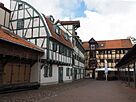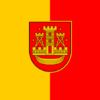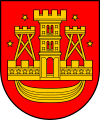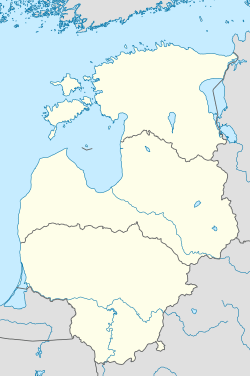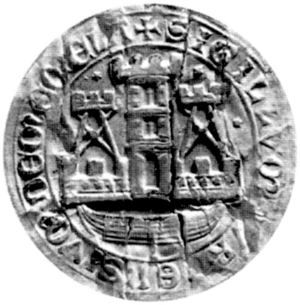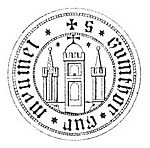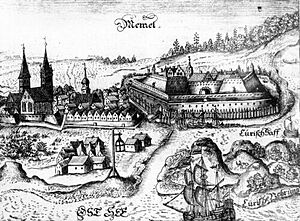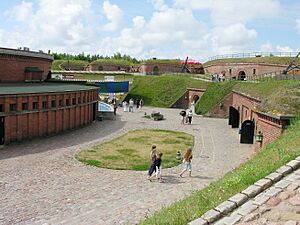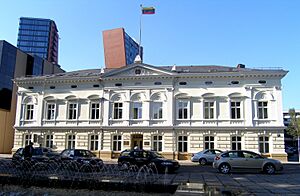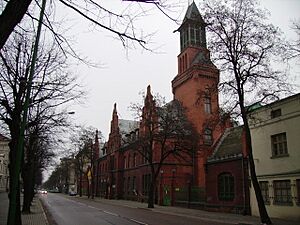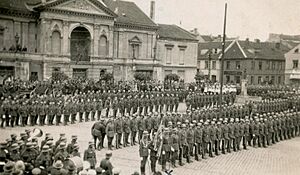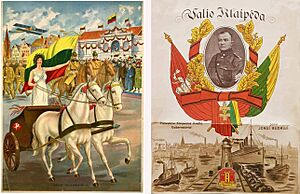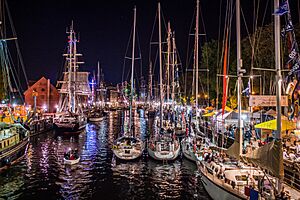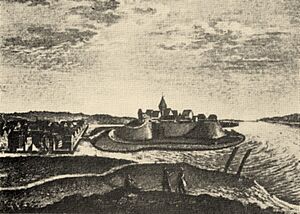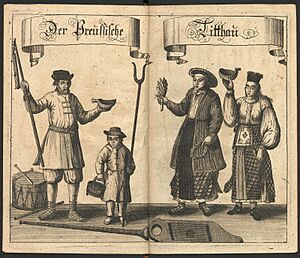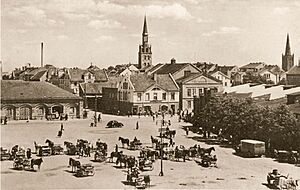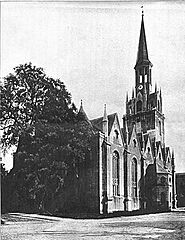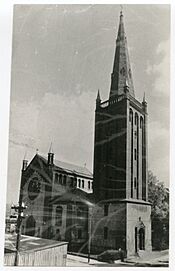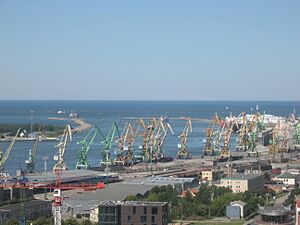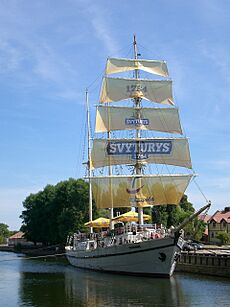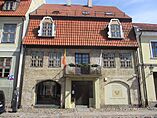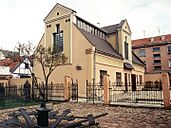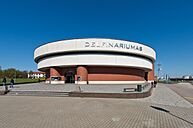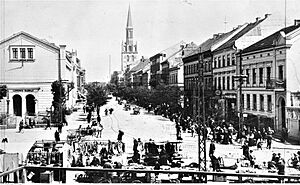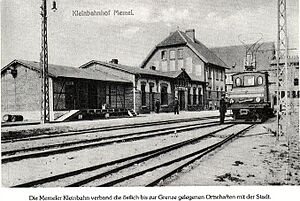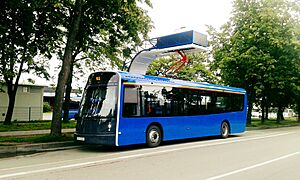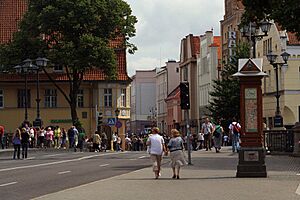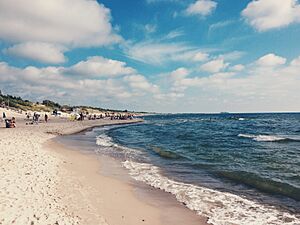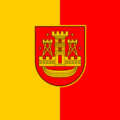Klaipėda facts for kids
Quick facts for kids
Klaipėda
|
|||||
|---|---|---|---|---|---|
|
City
|
|||||
|
|||||
|
|||||
| Nickname(s):
Uostamiestis (port city)
|
|||||
| Country | |||||
| Ethnographic region | Lithuania Minor | ||||
| County | Klaipėda County | ||||
| Municipality | Klaipėda city municipality | ||||
| Capital of | Klaipėda County Klaipėda city municipality |
||||
| First mentioned | 1252 | ||||
| Granted city rights | 1258 | ||||
| Elderships | Melnragė and Giruliai | ||||
| Area | |||||
| • City | 98.2 km2 (37.9 sq mi) | ||||
| • Metro | 1,434 km2 (554 sq mi) | ||||
| Elevation | 21 m (69 ft) | ||||
| Population
(2024)
|
|||||
| • City | 160,357 | ||||
| • Density | 1,633.0/km2 (4,229.4/sq mi) | ||||
| • Metro | 228,748 | ||||
| • Metro density | 146/km2 (380/sq mi) | ||||
| GDP | |||||
| • Metro | €7.0 billion (2022) | ||||
| Time zone | UTC+2 (EET) | ||||
| • Summer (DST) | UTC+3 (EEST) | ||||
| Postal code |
91100-96226
|
||||
| Area code(s) | (+370) 46 | ||||
| City budget | €362 million | ||||
| Climate | Cfb | ||||
Klaipėda is a city in Lithuania located on the Baltic Sea coast. It is the third largest city in Lithuania. It is also the fifth largest city in the Baltic States. Klaipėda is the capital of Klaipėda County. It is also Lithuania's only major seaport.
The city has a long and interesting history. Its location by the Port of Klaipėda has always been important. The port usually does not freeze in winter. Klaipėda is in a region called Lithuania Minor. It was once part of Prussia and later Germany. After World War I, it was under French control. In 1923, Lithuania took control of the city. It rejoined Germany in 1939. After World War II, it became part of Lithuania again. Klaipėda has been part of Lithuania since 1944.
The city's population has changed over time. Many people moved to the suburbs. The areas around the city have grown. These suburbs are connected to Klaipėda by bus lines and water supply. Many people living in the suburbs also work in Klaipėda. Nearby, you can find popular seaside resorts like Neringa and Palanga.
Contents
- City Names: Klaipėda's History
- City Symbols: Coat of Arms
- Klaipėda's Past: A Look at History
- Klaipėda's Weather: Climate Overview
- City Green Spaces: Parks and Forests
- City Population: Demographics
- Religion in Klaipėda
- City Government: Klaipėda Municipality
- Klaipėda's Port: A Gateway to the Sea
- City Life and Culture
- City Design and Buildings: Cityscape
- Learning in Klaipėda: Education
- Tall Buildings in Klaipėda
- Getting Around: Transportation
- Klaipėda's Old Town: Unique Charm
- Sports in Klaipėda
- Klaipėda's Economy
- News and Entertainment: Media
- Famous People from Klaipėda
- Partner Cities: Twin Towns
- Images for kids
- See also
City Names: Klaipėda's History
The Teutonic Knights built a castle here in 1252. They called it Memelburg, which later became Memel. This name was used officially for many years. From 1923 to 1939, both Memel and Klaipėda were used. Since 1945, the Lithuanian name Klaipėda has been official.
The name Klaipėda first appeared in Lithuanian writings in the 15th century. Some people believe Klaipėda means "boggy terrain" or "obstructed foot". This is because of the marshy ground. However, it likely comes from an old language called Curonian. It probably means "even ground" or "flat land". This describes the flat area where the city was first built.
The river Neman was called Mēmele or Mēmela by local tribes. This name means "mute" or "silent". It refers to the peaceful flow of the river. German speakers adopted this name, and it was also chosen for the city.
In the Samogitian language, the city's name is spelled Klaipieda. Other names for the city include Klaipēda (Latvian), Kłajpeda (Polish), and Клайпеда (Russian).
City Symbols: Coat of Arms
The Coat of arms of Klaipėda is also used by the Klaipėda city municipality. A designer named Kęstutis Mickevičius created the modern version. He based it on old city seals from the 1400s and 1600s. This modern coat of arms was approved on July 1, 1992.
Klaipėda's Past: A Look at History
Early Days: Teutonic Knights
People lived in this area as early as the 7th century. They were Baltic tribes. Klaipėda started as a trading center for these tribes. They traded with their German neighbors.
In the 1240s, the Teutonic Knights came to the region. They were a group of crusaders. They built a fort in 1252 called Memele castrum, or Memelburg. The fort was finished in 1253. It was guarded by the Teutonic Order's soldiers.
The fortress was used as a base for military campaigns. Local tribes tried to attack Memel in 1255, but they failed. Settlers from other parts of Europe also moved to Memel. It was even known as Neu-Dortmund, or "New Dortmund". Memel received special city rights in 1254 or 1258. Only a few cities in the State of the Teutonic Order had these rights.
In 1323, a Lithuanian army attacked the castle. Later, in 1360 and 1379, Lithuanian tribes sacked the castle and town. The castle was rebuilt and made stronger between 1422 and 1441. Its walls reached 7 meters high.
After a big battle called the Battle of Grunwald, there was a disagreement about the border. The Grand Duchy of Lithuania and the Teutonic Order both wanted control of certain areas. In 1413, a representative named Benedict Makrai decided that Lithuania should own the land around Klaipėda. He said the Memel Castle was in the land of the Samogitians.
However, the fighting continued. The Treaty of Melno in 1422 finally set the border. This border lasted for 501 years. Klaipėda remained with the Teutonic Order. In 1454, the city became part of the Kingdom of Poland. It was a fief held by the Teutonic Knights. The rebuilt town received new city rights in 1475.
Duchy of Prussia: A Time of Change
In 1525, the Duchy of Prussia was formed. Klaipėda adopted Lutheranism at this time. The city became an important center within the Duchy of Prussia. This started a long period of growth for the city and its port. Klaipėda served as a port for nearby Lithuania. It was good for exporting goods like wheat.
In 1618, the Duchy of Prussia was inherited by the Hohenzollern family. They were also rulers of Brandenburg. This meant Klaipėda became part of Brandenburg-Prussia. From 1629 to 1635, the city was occupied by Sweden during a war.
In 1656, a treaty opened Memel's harbor to Sweden. The city's income from the harbor was shared. In 1660, another treaty confirmed Brandenburg's rule over the region.
Work began in 1627 to build strong defenses around the city. This changed its future. In 1678, a Swedish army tried to capture Memel, but they failed.
Kingdom of Prussia: Growth and Importance
By the early 1700s, Memel was one of Prussia's strongest fortresses. In 1701, the town became part of the Kingdom of Prussia. Even with its defenses, Russian troops captured it in 1757 during the Seven Years' War. From 1757 to 1762, the city was under Russian control. After the war, the fortress was not maintained as well, but the town continued to grow.
In 1773, Memel became part of the new province of East Prussia. In the late 1700s, English traders came to Memel. They built the first sawmills there. Memel became known for its wood manufacturing. This brought wealth and stability to the city for over a hundred years.
Memel thrived in the late 18th century by exporting timber to Great Britain. This wood was used by the Royal Navy. In 1792, 756 British ships visited the town. They transported lumber from nearby forests. In 1800, Memel imported salt, iron, and herrings. Its exports, mainly corn, hemp, flax, and timber, were much larger. The Encyclopædia Britannica in 1815 called Memel "the finest harbour in the Baltic".
During the Napoleonic Wars, Memel became the temporary capital of the Kingdom of Prussia. King Frederick William III lived there from 1807 to 1808. In Memel, he signed a document in 1807. This document, called the October Edict, ended serfdom in Prussia. This led to important reforms. The area around Memel suffered economically during Napoleon Bonaparte's Continental System.
In 1863, during the January Uprising, Polish rebels tried to land near the city's harbor. But they were unsuccessful.
German Empire: A Northern City
After Germany became a united empire in 1871, Memel was its northernmost city.
The city grew in the 19th century due to the Industrial Revolution. Memel's population quadrupled. By 1910, it had 21,470 people. However, its growth was slower than other cities. This was partly because it was so far north and east in Germany. Most money for the province was spent in Königsberg.
Memel remained a key center for the Baltic timber trade. Steamer services connected Memel to other towns. A main railway line was built to Memel. It connected to St. Petersburg.
In the late 19th century, Memel was important for publishing books in the Lithuanian language. These books used the Latin-script alphabet. They were banned in the nearby Russian Empire, which controlled Lithuania. So, the books were secretly brought across the border.
In 1910, the Memel Territory had 149,766 people. About 67,345 spoke Lithuanian as their first language. Germans were the majority in the city and port. Lithuanians lived mostly in the rural areas.
Between Wars and World War II
After World War I, the Treaty of Versailles separated Klaipėda and its region from Germany. It became a special area managed by the Allied States. France was in charge for a while. Both Lithuania and Poland wanted the region.
Lithuania decided to take action. In January 1923, they staged the Klaipėda Revolt. They took control of the region by force. This happened while other European countries were busy. Germany quietly supported this. France offered little resistance. The League of Nations protested, but accepted the change in February 1923. A formal agreement, the Klaipėda Convention, was signed in Paris in 1924. It gave the region a lot of self-rule.
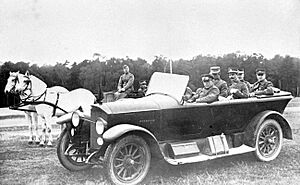
Taking control of Klaipėda was very important for Lithuania. The region produced up to 30% of Lithuania's economy. Between 70% and 80% of foreign trade went through Klaipėda. The region was only about 5% of Lithuania's land. But it had one-third of its industry.
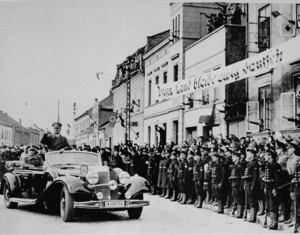
Nazi Germany wanted to get the region back. Tensions grew. Pro-German groups won elections in the Klaipėda Parliament. This parliament often disagreed with the Lithuanian leaders. Lithuania tried to make local Lithuanians feel more connected to Lithuania. But many locals resisted.
In 1939, German Foreign Minister Joachim von Ribbentrop gave Lithuania an ultimatum. He demanded that Klaipėda be given back to Germany. Lithuania could not get international support. So, it agreed to the demand on March 22, 1939. In return, Lithuania could still use the harbor. Adolf Hitler visited the harbor and gave a speech. This was Hitler's last land gain before World War II. During the war, forced labor camps were operated in the city.
After World War II: 1945 to Today
During World War II, the battle of Memel took place. The Soviet Red Army captured the city on January 28, 1945. Only about 50 people were left. After the war, the Klaipėda Region became part of the Lithuanian SSR.
The Soviets made Klaipėda a major fishing and marine base. Shipyards and a fishing port were built. By 1959, the city's population had doubled. By 1989, it had 202,900 people. At first, Russian speakers were in charge. But after Joseph Stalin died, more Lithuanians moved to the city. Lithuanians became the main ethnic group. However, Klaipėda still has a high percentage of Russian speakers compared to other large Lithuanian cities.
Until the 1970s, Klaipėda was mostly important for its economy. Cultural and religious activities were limited. A Roman Catholic Church was built, but its developers were arrested. The church was not allowed to open. Its tower was even torn down. It was turned into a concert hall. The church was returned to believers in 1987.
In the 1970s and 1980s, cultural life grew. The Klaipėda Sea Festival started. Thousands of people come to celebrate. Klaipėda University was founded in 1991. Today, Klaipėda has a German-Lithuanian school and an English-language university.
In 2014, Klaipėda had 64 visits from cruise ships. This was more than Riga, the capital of Latvia.
Klaipėda's Weather: Climate Overview
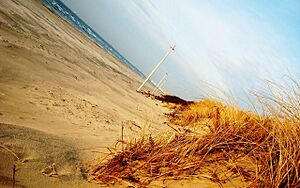
Klaipėda has an Oceanic climate. This means it has mild winters and cool summers. In July and August, the warmest months, high temperatures are around 20°C (68°F). Low temperatures are around 14°C (57°F). The highest temperature ever recorded was 36.6°C (97.9°F) in August 2014.
In January and February, the coldest months, high temperatures are around 0°C (32°F). Low temperatures are around -5°C (23°F). The coldest temperature ever recorded was -33.4°C (-28.1°F) in February 1956.
The most rain falls in August. April is the driest month.
City Green Spaces: Parks and Forests
Klaipėda has many parks and forests where people can enjoy nature.
- Martynas Mazvydas Sculpture Park
- Klaipeda University Botanical Garden
- Klaipeda Recreation Park
- Danė Pocket-Park
- Fisherman Statue Pocket-Park
- Draugystė Park (Friendship Park)
- Oak Grove Park
- Sąjūdis Park
- Jono kalnelis (Hill of John) park
Forests near Klaipėda include:
- Klaipeda Forest
- Giruliai Forest
- Smiltyne Forest
City Population: Demographics
| Historical population | ||
|---|---|---|
| Year | Pop. | ±% |
| 1722 | 3,400 | — |
| 1782 | 5,500 | +61.8% |
| 1790 | 6,300 | +14.5% |
| 1813 | 7,230 | +14.8% |
| 1823 | 5,300 | −26.7% |
| 1837 | 9,000 | +69.8% |
| 1855 | 17,000 | +88.9% |
| 1861 | 17,500 | +2.9% |
| 1875 | 20,000 | +14.3% |
| 1890 | 19,282 | −3.6% |
| 1897 | 20,100 | +4.2% |
| 1905 | 20,700 | +3.0% |
| 1912 | 23,500 | +13.5% |
| 1925 | 35,845 | +52.5% |
| 1931 | 37,142 | +3.6% |
| 1938 | 47,189 | +27.1% |
| 1950 | 48,500 | +2.8% |
| 1959 | 89,500 | +84.5% |
| 1961 | 106,243 | +18.7% |
| 1967 | 131,600 | +23.9% |
| 1970 | 140,342 | +6.6% |
| 1978 | 175,200 | +24.8% |
| 1979 | 176,648 | +0.8% |
| 1985 | 195,000 | +10.4% |
| 1989 | 202,929 | +4.1% |
| 1991 | 208,300 | +2.6% |
| 1992 | 207,100 | −0.6% |
| 1999 | 203,300 | −1.8% |
| 2001 | 192,954 | −5.1% |
| 2007 | 185,936 | −3.6% |
| 2008 | 184,657 | −0.7% |
| 2009 | 183,433 | −0.7% |
| 2010 | 182,752 | −0.4% |
| 2011 | 162,360 | −11.2% |
| 2014 | 157,305 | −3.1% |
| 2017 | 162,835 | +3.5% |
| 2018 | 149,015 | −8.5% |
| 2019 | 148,506 | −0.3% |
| 2020 (est.) | 154,332 | +3.9% |
Klaipėda was first built as a military outpost. It grew slowly at first. In its early centuries, it was attacked many times. It was burned or ruined about 20 times between the 13th and 15th centuries.
In the late 1400s, people started settling in Klaipėda's Old Town. This area was on a peninsula. The Klaipėda Castle was rebuilt, and people moved there.
Trade with Western countries helped Klaipėda grow. By 1503, there were 25 families of townspeople. By 1589, there were 143 families. Lithuanians and Curonians lived alongside German settlers. However, non-Germans were not allowed to join trade groups or have full city rights. Most city residents were Germans. But villages in Lithuania Minor had many Lithuanians. Klaipėda became an important center for Lithuania Minor.
In the 1700s, a plague killed many people in Lithuania Minor. After this, German settlers were encouraged to move to the area. They received special benefits.
In 1782, Klaipėda had 5,500 residents. By 1790, it had 6,300. During the Napoleonic Wars, Klaipėda was the temporary home of the Prussian King. In 1807, Frederick William III ended serfdom here. This led to more Lithuanians moving to Klaipėda. By 1837, they made up 10.1% of residents.
In 1855, a nearby area called Vitė was added to the city. The population grew to over 17,000. By 1875, it reached about 20,000. Before World War I, many Lithuanians in the region became part of the German nation. In 1915, the Russian army again affected Klaipėda's population.
After the Klaipėda Revolt in 1923, Klaipėda became part of Lithuania. The Lithuanian population in the city grew. In 1925, Lithuanians were 30.3% of Klaipėda's 35,845 people. Germans were 57.3%.
In 1939, Lithuania gave Klaipėda back to Nazi Germany. Soon after, World War II began. Most residents were moved to Germany. After the war, new residents came from Lithuania, Russia, Belarus, and Ukraine. They replaced the German-speaking population. Only six old residents remained in the city after the war.
Over the years, the Lithuanian population in Klaipėda continued to grow. In 1959, it was 55.2%. In 2011, it was 73.9%. As of 2020, Klaipėda's population was 154,332. In 2022, Lithuanians made up 80% of the population.
Religion in Klaipėda
The first church in Klaipėda was built in 1252. It was dedicated to Mary, mother of Jesus. It was planned for Klaipėda to be a center for the Bishopric of Courland. A St. Mary's Cathedral was built.
Two other churches were built: one for German settlers (Church of St. John) and one for local people (Church of St. Nicholas). Services were in Latin, with sermons in German. Translators helped local people understand.
After 1525, the Reformation spread Lutheranism. Services began to be held in the local languages, including Lithuanian. In 1620, the Lithuanian Parish of Klaipėda became independent. But its church was torn down in 1627 to build city walls. A new church for the Lithuanian Parish was built in 1686. Priests there knew Lithuanian and published texts in the language.
The Lithuanian Church was destroyed in a big fire in 1854. It was rebuilt with money from the community. It was later called the Church of St. Jacob. Many Lithuanians attended this church.
After the Klaipėda Revolt in 1923, more Catholics moved to Klaipėda. By 1939, there were 25,000 Catholics. In 1944, most Lutherans left to avoid Soviet rule. After the war, under state atheism in the Soviet period, many damaged churches were completely destroyed.
In 1956, there were 30,000 Catholics in Klaipėda. A new Catholic church was started in 1961. But the Soviet government stopped its construction. The church was turned into a concert hall. Priests who built it were imprisoned. The church was finally returned to believers in 1987.
Since Lithuania became independent in 1990, Klaipėda has a large Lithuanian Evangelical Lutheran Church parish. The Catholic Church in Klaipėda belongs to the Roman Catholic Diocese of Telšiai.
City Government: Klaipėda Municipality
The Klaipėda city municipality council is the main governing body. It makes laws for the city. The council has 31 members: 30 councillors and a mayor. They are elected directly by the people for four-year terms.
The council is part of the Association of Local Authorities in Lithuania.
City Leaders: Mayors
- 1990–1992 – Povilas Vasiliauskas
- 1992–1994 – Benediktas Petrauskas
- 1994–1995 – Jurgis Aušra
- 1995–1997 – Silverijus Šukys
- 1997–2000 and 2000–2001 – Eugenijus Gentvilas
- 2001–2003, 2003–2007, 2007–2011 – Rimantas Taraškevičius
- 2011–2015, 2015–2019, 2019–2023 – Vytautas Grubliauskas
- 2023–present – Arvydas Vaitkus
Klaipėda's Port: A Gateway to the Sea
The Port of Klaipėda is the main port on the eastern coast of the Baltic Sea that does not freeze in winter. It is a key transportation hub in Lithuania. It connects sea, land, and railway routes. Klaipėda is a versatile, deep-water port. Many companies work here, handling cargo, repairing ships, and building ships.
The port can handle up to 60 million tons of cargo each year. In 2022, it handled 36.1 million tons. It was visited by 5,605 ships. The port operates 24 hours a day, every day of the year.
City Life and Culture
Historic Places to See
Klaipėda's city center has many historic buildings. They date from the 13th to 18th centuries. Some old buildings have a special style called half-timbered construction. This style is also seen in Germany and other European countries.
Other interesting places include:
- The remains of Klaipėda Castle. It was built in the 13th century by the Teutonic Order.
- The Žardė ancient settlement. This old settlement dates back to the 10th century.
- Parts of the old "Dutch" defense system. These were built around the town in the 17th and 18th centuries.
- The maritime museum in Fort Wilhelm. This fort was built in the late 19th century.
Entertainment: Cinemas and Theatres
Cinemas:
- Arlekinas
- Forum cinemas
Theatres:
- Klaipėda Musical theatre
- Klaipėda Drama theatre
- Klaipėda Puppet theatre
- Apeironas theater
- Dance theater "Šokio teatras"
- Klaipėda youth theater "Klaipėdos jaunimo teatras"
Exploring the Past: Museums
- Blacksmiths museum
- Castle museum
- Clocks museum
- The History Museum of Lithuania Minor
- Maritime museum and Dolphinarium
Lithuanian Maritime Museum
The Lithuanian Maritime Museum is located in an old 19th-century fort. It has an aquarium with marine animals. You can see fish from Lithuania and tropical fish. The museum also has seals, sea lions, and penguins in outdoor pools. There are exhibits of shells, fossils, and ancient sea creatures.
Fun Events: Festivals
Klaipėda hosts many annual festivals. These include:
- Klaipėda Music Spring
- The Klaipėda Castle Jazz Festival
- Museum Nights
- The International Festival of Street Theatres
- The International Short Film Festival
- The Klaipėda Sea Festival
The Parbėg laivelis folk festival also takes place regularly. It features concerts, ship displays, and plays.
City Design and Buildings: Cityscape
Urban Planning and Architecture
Klaipėda is built in a long line along the Curonian Lagoon and the Baltic Sea. The main parts are the Old Town and newer residential areas. The city's port identity is clear. You can see quays, warehouses, and industrial buildings. The Old Town has a grid of streets. This was formed between the 13th and 15th centuries.
Some old defense structures still exist. The Klaipėda Castle and its bastions are on the left bank of the Danė River. Old public buildings like the Theater Palace (built in 1857) are also in the Old Town. Many buildings have half-timbered or brick styles.
After a fire in 1854, the city was rebuilt quickly. New historical buildings were constructed. These include the State Bank (1858), Courthouse (1862), and railway station (1875). The neo-Gothic Post Office (1890) is also notable.
Many homes and other buildings were also constructed. A neoclassical palace on Liepų Street is now the Klaipėda Clock and Watch Museum. Industrial buildings were built, like a gas factory (1861) and a pulp factory (1900). A bascule bridge was built in 1855. Ships had to pay a fee to pass, which helped the city's economy.
In the early 20th century, Jugendstil style buildings appeared. After Lithuania regained independence in 1923, new buildings were built. These included the Red Cross Hospital (1933) and Vytautas Magnus Gymnasium (1934).
During World War II, 60% of Klaipėda's buildings were destroyed. Many buildings that reminded people of German times were also torn down.
During the Soviet occupation, the historic part of Klaipėda was changed. A new church was started in 1957. But it was taken from believers in 1960 and used as a concert hall. It was returned in 1988. Other buildings from this time include the Palace of Culture (1963) and the Lithuanian Maritime Museum (1979). After Lithuania became independent again in 1990, new shopping centers, hotels, and homes were built.
Learning in Klaipėda: Education
Schools: Primary and Secondary Education
Klaipėda has been an education center since the 14th century. Early schools were often connected to churches. The first record of teachers in Klaipėda is from 1540. A separate Lithuanian Parochial School opened around 1620. But it was later demolished. A new Lithuanian Church and school were built in 1687. This school operated for almost 300 years.
In the early 1700s, King Frederick William I reformed the Prussian education system. He tried to make primary education available to everyone. Many new schools were set up in Lithuanian areas. Lutheranism encouraged using local languages in church schools. By the 18th century, there were 449 primary schools in Lithuanian counties. In 340 of them, students were taught in Lithuanian or German.
However, serfdom made it hard for Lithuanian children to study. Serfdom was ended in Prussia in 1763. In the 19th century, mixed schools often led to Lithuanian students learning German. During the time between the World Wars, Klaipėda became part of Lithuania. But in the Klaipėda Region, only four out of 102 schools were Lithuanian.
An upper school, the Great School, was established in the late 17th century. It became a gymnasium around 1850. In 1829, the Klaipėda Navigation School opened. It trained navigators and sea captains. The Klaipėda Teachers' Seminary opened in 1902. It prepared teachers who knew Lithuanian. In 1923, the Klaipėda Conservatory was founded. It still trains musicians today.
Currently, Klaipėda has 12 gymnasiums, 3 primary schools, 17 progymnasiums, and 4 elementary schools. Many students in Klaipėda go on to universities or colleges. Lithuania is a leading country in higher education.
Universities and Colleges: Tertiary Education
Klaipėda did not have its own university for a long time. Many people from Klaipėda studied at the University of Königsberg. This university was established in 1544. It had a Lithuanian language seminar, which was the first of its kind.
Between the World Wars, three high schools were established in Klaipėda. These included the Klaipėda Trade Institute and the Klaipėda Pedagogical Institute. There were plans for a university. But the German takeover in 1939 and later Soviet rule stopped this.
During the Soviet period, branches of other institutes were opened in Klaipėda. In 1990, after Lithuania regained independence, these were combined to create Klaipėda University. The university has different faculties, including Marine Technology and Natural Sciences. It also has research institutes. Over 3,000 students study at Klaipėda University each year.
Another university in Klaipėda is the LCC International University. It is a Christian university that offers a liberal arts education. Many of its students come from other countries.
Klaipėda also has four colleges: Klaipėda University of Applied Sciences, Lithuania Business College, SMK High School, and Lithuanian Maritime Academy. Parts of the Vilnius Academy of Arts and Lithuanian Academy of Music and Theatre are also in Klaipėda.

Books and Knowledge: Libraries
Klaipėda has several libraries. The most well-known are:
- Klaipėda University Library (established in 1991)
- Klaipėda City Municipality Imanuel Kant Public Library (established in 1920)
- Klaipėda County Ieva Simonaitytė Public Library (established in 1950)
Tall Buildings in Klaipėda
The tallest building in Klaipėda is Pilsotas. It has 34 floors.
| Name | Stories | Height | Built | Purpose | Status |
|---|---|---|---|---|---|
| Pilsotas | 34 | 111.9 m. | 2007 | Residential | Built |
| BIG 2 Complex | 25 | 72–82 m. | 2009 | Mixed use | Built |
| K Tower | 20 | 71.9 m. | 2006 | Office | Built |
| D Tower | 20 | 71.9 m. | 2006 | Residential | Built |
| Klaipėdos burė | 22 | 66 m. | 2009 | Residential | Built |
| Aukštoji Smeltė | 20 | 66 m. | 2009 | Residential | Under construction |
| Minijos Banga | 20 | 62.2 m. | 2007 | Residential | Built |
| Neapolis Business Centre | 16 | 56.7 m. | 2007 | Office | Built |
| Baltijos Avenue Tower | 15 | 50 m. | 2002 | Residential | Built |
| Vėtrungė | 13 | 42 m. | – | Retail | Built |
Getting Around: Transportation
Trains: Railway Station
The Klaipėda railway station is located north of the Old Town. It has two buildings. The old building, made of yellow bricks, was built in 1881. The new building, made of red bricks, was built in 1983.
The railway network reached Klaipėda in 1878. It was first used for lumber and fish. After Klaipėda became part of Lithuania in 1923, the railway network grew.
As of 2017, Lithuanian Railways operates trains from Klaipėda. There are 4 daily trains to Vilnius and 2 daily trains to Radviliškis.
Buses serve the railway station:
- No. 9: south of the city – city hospital
- No. 6: south of the city – Melnragė beaches
- No. 8: south of city – bus station (through Old town)
- No. 15: south of the city – city hospital
- No. 100: bus station – Palanga International Airport
Flights: Airport
Palanga International Airport provides flights for Klaipėda. It has domestic and international flights. A city bus connects the airport with Klaipėda.
Klaipėda also has a small private airfield. It is used for sports aviation and charter flights.
Boats: Ferries
Ferries to Smiltynė
Klaipėda is next to the Curonian Spit. A part of the peninsula, Smiltynė, is within Klaipėda. You can reach it by ferry from two terminals:
- The Old ferry terminal (Danės st. 1): for passengers on foot or with bikes.
- The New ferry terminal (Nemuno st. 8): for people with cars and other vehicles.
International Ferries
Klaipėda has three international ferry lines. Two companies operate them: DFDS Seaways and TT-Line.
Ferries leave from the Central Klaipėda Terminal. DFDS goes to Kiel (Germany) and Karlshamn (Sweden). TT-Line goes to Trelleborg (Sweden).
Buses: City and Long-Distance
Klaipėda's city buses run mostly north-south. They follow three main streets along the Curonian Lagoon. This makes it easy to get around.
You can buy electronic cards in shops to pay for bus rides. The Klaipėda city passenger transport organizes the public transport.
Buses to other cities leave from the Klaipėda bus station. Buses to villages on the Curonian Spit leave from a stop in Smiltynė.
Trams: A Look Back and Forward
Trams in Klaipėda ran from 1904 to 1934 and from 1950 to 1967. It was the only tram system in Lithuania's history. The tram system had two lines. They were used to deliver goods from railways and ports. The trams eventually stopped running because they were old and there was no money to fix them.
City leaders are now planning to bring back the tram system. They want to connect Klaipėda to Šventoji and Palanga. A study began in 2017 for the first new tram line.
Klaipėda's Old Town: Unique Charm
Klaipėda's Old Town is special in Lithuania. It has many buildings in German and Scandinavian styles. Its unique fachwerk architectural style and planned street layout are different from other old towns in Lithuania. The streets are very straight and cross at right angles.
One of the most popular places is The Theatre Square. It hosts concerts, the Sea Festival, and a Jazz Festival. A famous sculpture in the square is the Taravos Anikė. It shows a young girl and honors the poet Simonas Dachas.
Sports in Klaipėda
| Club | Sport | League | Venue |
|---|---|---|---|
| Neptūnas | Basketball | Lithuanian Basketball League (LKL), Eurocup (Eurocup) | Švyturio Arena |
| Nafta-Uni-Laivitė | Basketball | National Basketball League (NKL) | Žalgirio sporto rūmai |
| Tekoda | Basketball | Regional Basketball League (RKL) | Žalgirio sporto rūmai |
| LCC TU | Basketball | Regional Basketball League (RKL) | Michaelsen Centre |
| Klaipėdos Fortūna | Basketball | Lithuanian Women Basketball League (LMKL) | Žalgirio Sporto Rūmai |
| Dragūnas | Handball | Lithuanian Handball League (LRL) | Neptūnas Hall |
| Kuršiai | Rugby | Lithuanian Rugby Union I Group | Žalgiris Stadium |
| Atlantas | Football | defunct | |
| FK Klaipedos Granitas | Football | defunct | |
| FK Sendvaris | Football | Sunday football league SFL League (SFL Lyga) | Football school stadium |
| Sadvita | Hockey | Lithuania Hockey League (NVLRL) | Klaipedos Akropolis Ice Arena |
| Skatas - 95 | Hockey | Lithuania Hockey League (NVLRL) | Klaipedos Akropolis Ice Arena |
| Kirai | Hockey | Lithuania Hockey League (NVLRL) | Klaipedos Akropolis Ice Arena |
| Toras | Hockey | Lithuania Hockey League (NVLRL) | Klaipedos Akropolis Ice Arena |
| Marių Meškos | Ultimate | Lithuanian Ultimate Frisbee federation I group | Smiltynė beach, Indoor halls |
| Ultimate | SUN BEAM (tournament) | Smiltynė beach | |
| Scala dream | Rock climbing | Inhouse climbing club with top Lithuanian climbers | Indoor climbing facility |
| Fabrique | Rock climbing | Inhouse climbing club with top Lithuanian climbers | Indoor climbing facility |
Klaipėda's Economy
Klaipėda produces about 12 percent of Lithuania's total economic output. It generates about 80 percent of western Lithuania's output. Much of Klaipėda's economy relies on trade through the Port of Klaipėda.
In the eastern part of the city, there is the Klaipėda Free Economic Zone. Companies here get tax benefits for their first 6 years.
Klaipėda is also home to the first Geothermal Demonstration Plant in the Baltic States. This plant provides geothermal heating. In 2014, the Klaipėda LNG FSRU with the FSRU Independence ship opened. This gave Lithuania another way to get gas.
Most of the city's economy comes from the service sector. People in Klaipėda generally earn more than the average in Lithuania. Some companies in Klaipėda include BLRT Western Shipyard, DFDS Lisco, Švyturys brewery, and Grigeo Klaipėda.
News and Entertainment: Media
Radio Stations
- Radijas 9 91.4 FM
- Laluna 94.9 FM
- Kelyje 99.8 FM
- Raduga 100.8 FM
- European Hit Radio 96.2 FM
- Power Hit Radio 96.7 FM
- Zip FM 92.5 FM
Television Channel
- Balticum TV
Newspapers
- Vakarų ekspresas
- Klaipeda
Famous People from Klaipėda
- Simon Dach (1605–1659), a poet who wrote the Ännchen von Tharau song.
- Friedrich Wilhelm Argelander (1799–1875), an astronomer.
- Yisrael Salanter (1810–1883), a religious leader.
- David Wolffsohn (1856–1914), a leader of the World Zionist Organization.
- Tomas Venclova (born 1937), a poet and author.
- Lena Valaitis (born 1943), a pop singer.
- Leonidas Donskis (1962–2016), a philosopher.
- Gitanas Nausėda, (born 1964), the current President of Lithuania.
- Eurelijus Žukauskas (born 1973), a European basketball champion.
- Tomas Danilevičius (born 1978), a football (soccer) player.
- Arvydas Macijauskas (born 1980), a European basketball champion.
- Monika Liu, (born 1988), a singer-songwriter who represented Lithuania in the Eurovision Song Contest 2022.
Partner Cities: Twin Towns
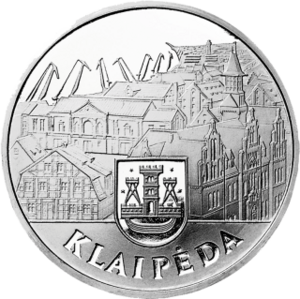
Klaipėda has special partnerships with these cities:
The city used to be twinned with:
 Cherepovets, Russia
Cherepovets, Russia Kaliningrad, Russia
Kaliningrad, Russia Mogilev, Belarus
Mogilev, Belarus
Cooperation Agreements
Klaipėda also has a cooperation agreement with:
 Porto, Portugal
Porto, Portugal
Images for kids
See also
 In Spanish: Klaipėda para niños
In Spanish: Klaipėda para niños




